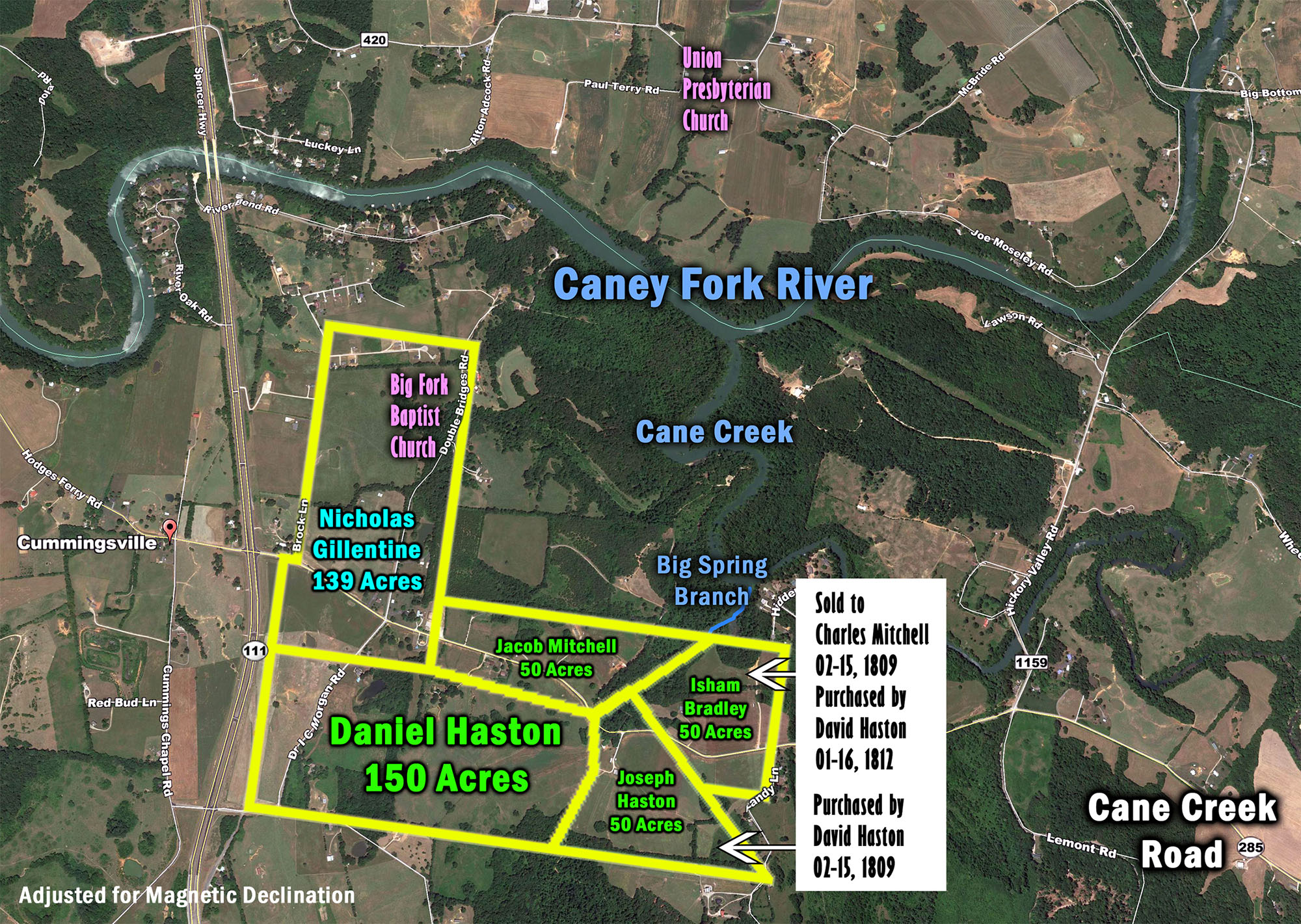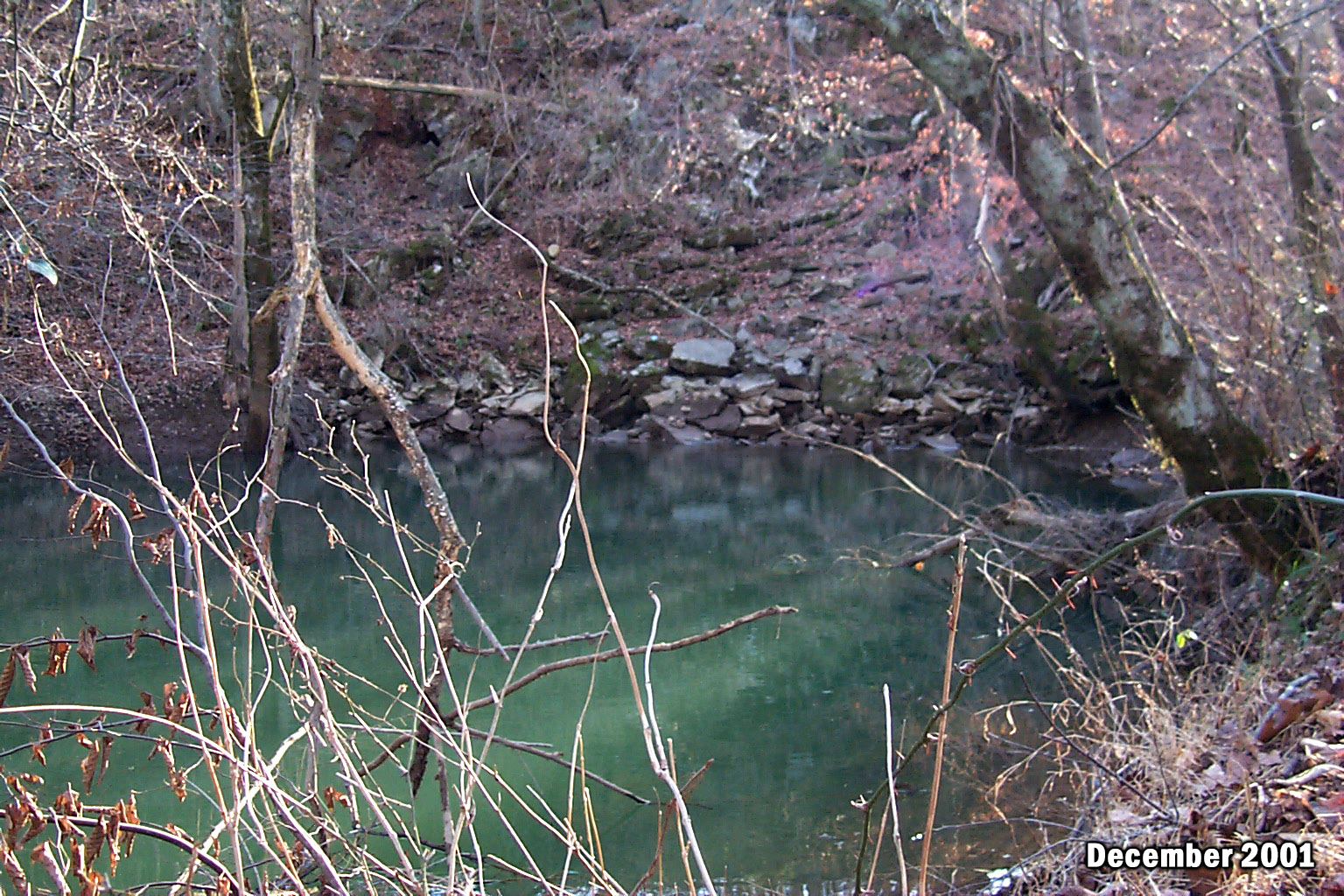31 - Daniel Haston & Other White County, TN Big Spring Settlers

The area south of the Caney Fork River near the mouth of Cane Creek was a prominent settlement in the early 1800s. It was part of White County, Tennessee prior to its inclusion into newly formed Van Buren County in 1840. The abundance of water sources in that area was probably a major reason that early land-seeking settlers found the region so attractive. And since the land was covered in canebrakes, it was much easier to clear than timbered land.
A large perpetual spring flows into Cane Creek approximately one half mile before Cane Creek itself empties into the Caney Fork River. Early documents refer to this feeder stream as “Big Spring” or “Big Spring Branch.” The spring is certainly not impressive in the length of the stream, but the amount of crystal clear water that flows out of the mouth of the spring is quite impressive. Big Spring emerges from the base of the north side of the Cumberland Mountain and meanders only a few hundred yards before spilling into Cane Creek.

The quality and quantity of this water source, must have made the land surrounding Big Spring the prime homestead location for miles up and down the south side of the Caney Fork. Thus, we can probably assume that the families that claimed Big Spring as a focal point for their homesteads were some of the earliest settlers of that area.
In the pioneer years of early America, neighbors, friends, and family members often moved together as a group. At least three (but probably more) families accompanied Daniel Haston to White County and settled in a cluster of homesites around the Big Spring Branch that became known as the Haston Big Spring. The three families were all connected to Daniel Haston but in different ways.
The map at the top of this page clearly indicates that the four families strategically situated their claims in such a way as to provide access to the cool, clear, dependable waters of the Big Spring. A closer look at the dates on the map suggests that the placement of these claims was a well-planned, collective effort on the part of these four pioneer families. All four homesteads were officially located on the same day, August 28, 1807. Although the locations of their claims were made “official” on this day, there is evidence that they were “squatters” on these pieces of land for months, if not a few years, prior to August 1807. All four of these men, Isham Bradley, Jacob Mitchell, Joseph Haston, and Daniel Haston, signed the petition to form White County on July 22, 1806.
“Prior to 1805-1806, legally there were no rights for persons who may have settled in present day White, Van Buren, or Warren Counties. That land was still in fact legally the territory of the Cherokee. These early settlers were at some risk being there, but once the land had been ceded by the Indians, these hardy occupants were possessors of prize land. They could straightway begin the process of making entry, survey, and the issuance of a grant.”[i]
[i] Landon Daryle Medley, The History of Van Buren County, Tennessee: The Early Canebrakers (1840-1940). (Spencer, TN: published by author), 32.
The Four "Big Spring Branch" Settlers
Daniel Haston. As far as we know, this was the first property that Daniel Haston lived on that belonged to him, even though he was more than fifty years old at this time. He was definitely the “patriarch” of the group, since the head of the spring was on his property.
At the time the Hastons, Bradleys, and Mitchells initially settled the Big Spring area, they were probably living in constant danger of Indian attacks, since they were illegally squatting on Indian hunting lands. Monroe Seals stated, “Even after the Treaty of Tellico there were numerous skirmishes between whites and Indians.” One man born in White County in 1800, “told of numerous conflicts between whites and Indians during his boyhood.”[i]
[i] Seals, 5.
Although I know of no hard documentation to support the claim, there is some oral history that says a fortified station was erected on Daniel Haston’s property in order to provide protection from such attacks. It was supposedly known in those days as the “Haston Station.” The convenient access to Big Spring would have made it a logical place of refuge.
Joseph Haston. Joseph was Daniel’s 2nd son. The Big Spring flowed 495 feet down Joseph’s northwest property line. Joseph sold this tract to his brother David on February 15, 1809. On September 11, 1806 David was still in Knox County settling the sale of his 111 acres to Ezekiel Baldwin for $490.00. David’s first known appearance in White County was February 10, 1808 as a road worker, but he must have been in the county earlier enough to have been known. Joseph was probably commissioned by David to purchase the White County land and hold it for him until he could settle his Knox County business, move to White County, and settle his family.
Jacob Mitchell. Although Jacob Mitchell’s land did not have direct access to the head of the spring, his property line ran along Big Spring Branch for some 1500 feet, which gave him more frontage to the stream than any of the four Big Spring area tracts. Jacob Mitchell was a son-in-law of Daniel Haston, husband to Daniel’s daughter Lucinda.
Isham Bradley. Isham Bradley’s relationship to the Daniel Haston family can be traced back to Knox and Blount Counties, Tennessee. Isham was the bondsman for David Haston’s May 5, 1800 marriage to Peggy Roddy. And David had filled the same role for Isham Bradley’s marriage to Susana Matlocks on May 13, 1798 in Blount County. Was he a relative to the Hastons or just a friend? Since we know he married Susana Matlocks, he must not have been a son-in-law of Daniel Haston, as was Jacob Mitchell. Whatever the relationship was, it was strong enough for him to travel to the wilderness of middle Tennessee in order to settle adjacent to the Haston family (even before his marriage bondsman friend David arrived to the area).

